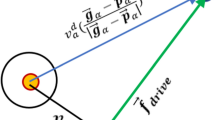Abstract
Freestyle formations appear widely in animation of groups. Most existing algorithms for generating special formations focus on the visualization performances of target formations, while social dynamics factors in the process of crowd motion are ignored. Thus, disregarding those factors will decrease the bionic features and fidelity of the crowd motion. According to this problem, a method based on bionic intelligence algorithm and self-adaptive evaluation to generate special formations is proposed in this paper. Simulation effect with good fluency and lively interaction is generated by means of user interaction, data analysis and crowd motion. In this method, 3D reconstruction is used to repaint characters, graphics or patterns in the 3D modeling system to build the basic virtual scene. Then, station points are generated through interlacing cross sampling. Based on the concentric circles model of fitness, each individual, self-adaptively, chooses a target station point which matches it aptly. Finally, the Artificial Bee Colony algorithm is used for path planing to generate the optimum route to the destination without collision. Visual simulation experiments are also made on the platforms of ACIS/HOOPS and Maya. The results show that this method can generate the optimum target formation with natural motion features and in accordance with users’ input. This method is also insensitive to the scale of crowd, exhibiting good performance when the number of individuals is large.












Similar content being viewed by others
References
Braun, A., Musse, S.R., de Oliveira, L.P.L., et al.: Modeling individual behaviors in crowd simulation. In: 16th International Conference on IEEE Computer Animation and Social Agents, pp. 143–148 (2003)
Pelechano, N., O’Brien, K., Silverman, B., et al.: Crowd simulation incorporating agent psychological models, roles and communication. Pennsylvania Univ Philadelphia Center For Human Modeling And, Simulation (2005)
Thalmann, D.: Crowd Simulation. Wiley, New York (2007)
Paris, S., Donikian, S., Bonvalet, N.: Environmental abstraction and path panning techniques for realistic crowd simulation. Comput. Animat. Virtual Worlds 17(3–4), 325–335 (2006)
Luo, L., Zhou, S., Cai, W., et al.: Agent-based human behavior modeling for crowd simulation. Comput. Animat. Virtual Worlds 19(3–4), 271–281 (2008)
Chen, Y., Lin, Y.: Controlling the movement of crowds in computer graphics by using the mechanism of particle swarm optimization. Appl. Soft Comput. 9(3), 1170–1176 (2009)
Bo, Y., Cheng, W., Hua, H., et al.: A multi-agent and PSO based simulation for human behavior in emergency evacuation. In: 2007 International Conference on IEEE Computational Intelligence and Security, pp. 296–300 (2007)
Banarjee, S., Grosan, C., Abraham, A.: Emotional ant based modeling of crowd dynamics. In: Seventh International Symposium on IEEE Symbolic and Numeric Algorithms for Scientific Computing, 2005 SYNASC 2005 (2005)
Helbing, D., Farkas, I., Vicsek, T.: Simulating dynamical features of escape panic. Lett. Nat. 407(6803), 487–490 (2000)
Yang, L., Li, J., Zhao, D.: Evacuation microcosmic disperse model based on individual’s behavior. Sci. China Ser. E: Eng. Mater. Sci. 34(11), 487–490 (2000)
Zhao, S., Su, G., He, Y.: Research of emergency evacuation system simulation based on cellular automata. J. Chin. Comput. Syst. 28(12), 2220–2224 (2007)
Takahashi, S., Yoshida, K., Kwon, T., et al.: Spectral-based group formation control. In: Computer Graphics Forum, vol. 28, no. 2, pp. 639–648. Blackwell Publishing, Oxford (2009)
Pelechano, N., Allbeck, J.M., Badler. N.I.: Controlling individual agents in high-density crowd simulation. In: Proceedings of the 2007 ACM SIGGRAPH/Eurographics symposium on Computer animation. Eurographics Association, pp. 99–108 (2007)
Silveira, R., Prestes, E., Nedel, L.P.: Managing coherent groups. Comput. Animat. Virtual Worlds 19(3–4), 295–305 (2008)
Gu, Q., Deng, Z.: Generating freestyle group formations in agent-based crowd simulations. Comput. Graphics Appl. 33(1), 20–31 (2013)
Gu, Q., Deng, Z.: Formation sketching: an approach to stylize groups in crowd simulation. In: Proceedings of Graphics Interface 2011. Canadian Human-Computer Communications Society, pp. 1–8 (2011)
Li, J., Mao, T., Jiang, H.: Shape constraining and control in crowd animation. J. Comput. Aided Design Comput. Graphics 22(7), 1158–1165 (2010)
Ioannidis, K., Sirakoulis, G.C., Andreadis, I.: Cellular ants: a method to create collision free trajectories for a cooperative robot team. Robot. Auton. Syst. 59(2), 113–127 (2011)
Zhao, W., Tan, R., Li, Y.: Real time collision detection algorithm in complex virtual environment. J. Syst. Simul. 22(1), 125–129 (2010)
Karaboga, D.: An idea based on honey bee swarm for numerical optimization. Technical Report-TR06, Erciyes University (2005)
Karaboga, D., Basturk, B.: A powerful and efficient algorithm for numerical function optimization: artificial bee colony (ABC) algorithm. J. Global Optim 39(3), 459–471 (2007)
Sun, Y., Liu, H., Cao, J.: Path generation method for swarm animation based on artificial bee colony algorithm. Comput. Eng. 37(22), 131–133 (2011)
Karaboga, D., Basturk, B.: On the performance of artificial bee colony algorithm. Appl. Soft Comput. 8(1), 687–697 (2008)
Bao, L., Zeng, J.: Comparison and analysis of the selection mechanism in the artificial bee colony algorithm. In: 2009 Ninth International Conference on IEEE Hybrid Intelligent Systems, vol. 1, pp. 411–416 (2009)
Li, Z., Si, G., Hu, X.: Research on modeling &simulation of crowd behavior based on smart environment. J. Syst. Simul. 20(s), 195–201 (2008)
Zheng, X., Liu, H.: A multi-objective evaluation based cooperative character modeling system. In: 2011 15th International Conference on IEEE Computer Supported Cooperative Work in Design (CSCWD), pp. 168–174 (2011)
Acknowledgments
This research is supported by: the Natural Science Foundation of China under Grant Nos. 61272094, 61202225, 61303007, 61303157; the Natural Science Foundation of Shandong Province under Grant No. ZR2010QL01; and the Project of Shandong Province Higher Educational Science and Technology Program under Grant Nos. J11LG32, J13LN13.
Author information
Authors and Affiliations
Corresponding author
Rights and permissions
About this article
Cite this article
Zhang, P., Liu, H. & Ding, Yh. Crowd simulation based on constrained and controlled group formation. Vis Comput 31, 5–18 (2015). https://doi.org/10.1007/s00371-013-0900-7
Published:
Issue Date:
DOI: https://doi.org/10.1007/s00371-013-0900-7




